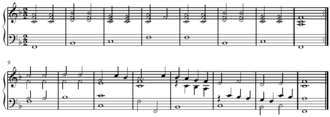Bergamask
For the regional language, see Bergamasque.

Bergamesca ('The Buffens'), Straloch MS., c. 1600[1]  Play .
Play .

Bergamesca variant, MS. Lute Book, c. 1600[1]  Play .
Play .
Bergamask, bergomask, bergamesca,[1] or bergamasca (from the town of Bergamo in Northern Italy), is a dance and associated melody and chord progression. It was considered a clumsy rustic dance (cf. Shakespeare, A Midsummer Night's Dream, v. 360) copied from the natives of Bergamo, reputed (according to the Encyclopaedia Britannica Eleventh Edition) to be very awkward in their manners.[2]
The dance is associated with clowns or buffoonery, as is the area of Bergamo, it having lent its dialect to the Italian buffoons.[1]
I-IV-V-I:[3]
Bergomask is the title of the second of the Two Pieces for Piano (1925) by John Ireland (1879–1972).
See also
Sources
- 1 2 3 4 (1916). The Musical Times, Volume 57, p.491.
- ↑
 One or more of the preceding sentences incorporates text from a publication now in the public domain: Chisholm, Hugh, ed. (1911). "Bergamask". Encyclopædia Britannica. 3 (11th ed.). Cambridge University Press. p. 772.
One or more of the preceding sentences incorporates text from a publication now in the public domain: Chisholm, Hugh, ed. (1911). "Bergamask". Encyclopædia Britannica. 3 (11th ed.). Cambridge University Press. p. 772. - ↑ Apel, Willi (1969). Harvard Dictionary of Music, p.91. ISBN 978-0-674-37501-7.
This article is issued from Wikipedia - version of the 11/15/2016. The text is available under the Creative Commons Attribution/Share Alike but additional terms may apply for the media files.